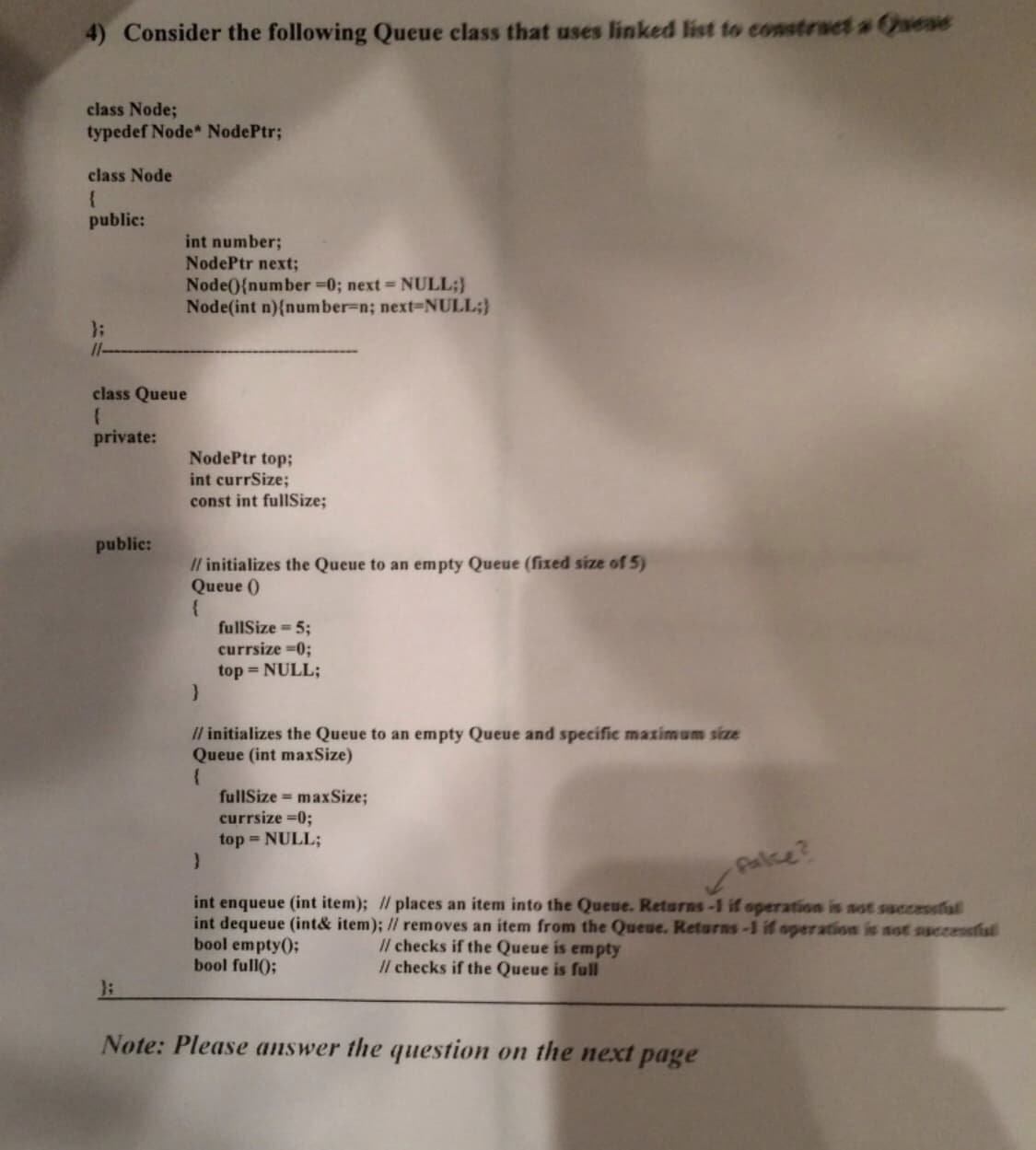4) Consider the following Queue class that uses linked list to constract a Queae class Node; typedef Node NodePtr; class Node public: int number; NodePtr next; Node({number =0; next NULL;} Node(int n){number=n; next-NULL;} 11- class Queue private: NodePtr top; int currSize; const int fullSize; public: I/ initializes the Queue to an empty Queue (fixed size of 5) Queue () fullSize = 5; currsize =0; top = NULL; I/ initializes the Queue to an empty Queue and specific maximum size Queue (int maxSize) fullSize = maxSize; currsize =0; top NULL; Palke? int enqueue (int item); // places an item into the Queue. Returns-1 if operation is soE saccessfal int dequeue (int& item); // removes an item from the Queue. Returns-1 if operation is not succesfist bool empty0; bool full(); Il checks if the Queue is empty Il checks if the Queue is full Note: Please answer the question on the next page
4) Consider the following Queue class that uses linked list to constract a Queae class Node; typedef Node NodePtr; class Node public: int number; NodePtr next; Node({number =0; next NULL;} Node(int n){number=n; next-NULL;} 11- class Queue private: NodePtr top; int currSize; const int fullSize; public: I/ initializes the Queue to an empty Queue (fixed size of 5) Queue () fullSize = 5; currsize =0; top = NULL; I/ initializes the Queue to an empty Queue and specific maximum size Queue (int maxSize) fullSize = maxSize; currsize =0; top NULL; Palke? int enqueue (int item); // places an item into the Queue. Returns-1 if operation is soE saccessfal int dequeue (int& item); // removes an item from the Queue. Returns-1 if operation is not succesfist bool empty0; bool full(); Il checks if the Queue is empty Il checks if the Queue is full Note: Please answer the question on the next page
C++ Programming: From Problem Analysis to Program Design
8th Edition
ISBN:9781337102087
Author:D. S. Malik
Publisher:D. S. Malik
Chapter17: Linked Lists
Section: Chapter Questions
Problem 10PE
Related questions
Question
Please help with the follow question in C++

Transcribed Image Text:4) Consider the following Queue class that uses linked list to constract a Queae
class Node;
typedef Node NodePtr;
class Node
public:
int number;
NodePtr next;
Node({number =0; next NULL;}
Node(int n){number=n; next-NULL;}
11-
class Queue
private:
NodePtr top;
int currSize;
const int fullSize;
public:
I/ initializes the Queue to an empty Queue (fixed size of 5)
Queue ()
fullSize = 5;
currsize =0;
top = NULL;
I/ initializes the Queue to an empty Queue and specific maximum size
Queue (int maxSize)
fullSize = maxSize;
currsize =0;
top NULL;
Palke?
int enqueue (int item); // places an item into the Queue. Returns-1 if operation is soE saccessfal
int dequeue (int& item); // removes an item from the Queue. Returns-1 if operation is not succesfist
bool empty0;
bool full();
Il checks if the Queue is empty
Il checks if the Queue is full
Note: Please answer the question on the next page
Expert Solution
This question has been solved!
Explore an expertly crafted, step-by-step solution for a thorough understanding of key concepts.
This is a popular solution!
Trending now
This is a popular solution!
Step by step
Solved in 3 steps with 2 images

Knowledge Booster
Learn more about
Need a deep-dive on the concept behind this application? Look no further. Learn more about this topic, computer-science and related others by exploring similar questions and additional content below.Recommended textbooks for you

C++ Programming: From Problem Analysis to Program…
Computer Science
ISBN:
9781337102087
Author:
D. S. Malik
Publisher:
Cengage Learning

C++ Programming: From Problem Analysis to Program…
Computer Science
ISBN:
9781337102087
Author:
D. S. Malik
Publisher:
Cengage Learning